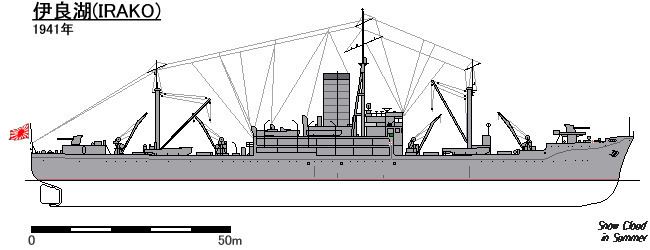Operators Imperial Japanese Navy Built 1940–1941 Launched 14 February 1941 | Preceded by Mamiya Construction started 30 May 1940 Draft 6.05 m | |
 | ||
Name Irako class food supply ship Builders Kawasaki Shipbuilding Corporation Cost 4,000,000 JPY as Irako
17,378,000 JPY as Kusumi Builder Kawasaki Shipbuilding Corporation | ||
Japanese food supply ship irako
Irako (伊良湖) was a Japanese food supply ship, serving during the Second World War. Constructed for the transport of food-stuffs, the Irako was eventually commissioned for other roles, including troop transport, munitions transport, and Pacific survey missions. Serving throughout the entirety of the Second World War, the Irako was eventually salvaged for metal, and used for public housing projects in Japan. The crew of the Irako is honored, along with many other seamen, in Tokyo, Japan.
Contents
The ship was named for Cape Irago, at the tip of Atsumi Peninsula in Aichi prefecture.
Construction
She was built in 1937 under the 3rd Naval Armaments Supplement Programme, in preparation for the anticipated war with the United States. She was intended to supplement the Combined Fleet's existing food supply ship Mamiya. Her design was similar to that of Mamiya, but she was smaller. Her warehouse was able to supply 25,000 men over two weeks. A sister ship, Kusumi, was planned in 1942 under the Modified 5th Naval Armaments Supplement Programme, but construction was cancelled after the start of the Solomon Islands campaign.
Service
Irako was completed and assigned to the Combined fleet on 5 December 1941. In January 1942, she started sailing between the Japanese homeland (Kure and Yokosuka) to the front, including Saipan, Truk, and Davao. Starting in April of that year, she started sailing to Singapore from the Japanese mainland as well. In August, she started making what would eventually be 12 trips to Truk from the mainland.
On 20 January 1944, she sustained heavy damage in an attack by USS Seadragon north of Truk 08°04′N 152°40′E. On 5 July, she was assigned to the Southwest Area Fleet, where she underwent repairs, which were completed in August 1944. She was dispatched to Manila Bay soon afterwards with convoy Hi-71, arriving on 2 September. She was present for the air raid carried out by Task Force 38 on 21 September, saving survivors from the destroyer Satsuki. On 22 September, she headed toward Coron Bay, only to be damaged during an air raid by aircraft of Task Force 38 at 11°59′N 120°02′E and scuttled on 24 September. She was decommissioned on 30 November 1945.
